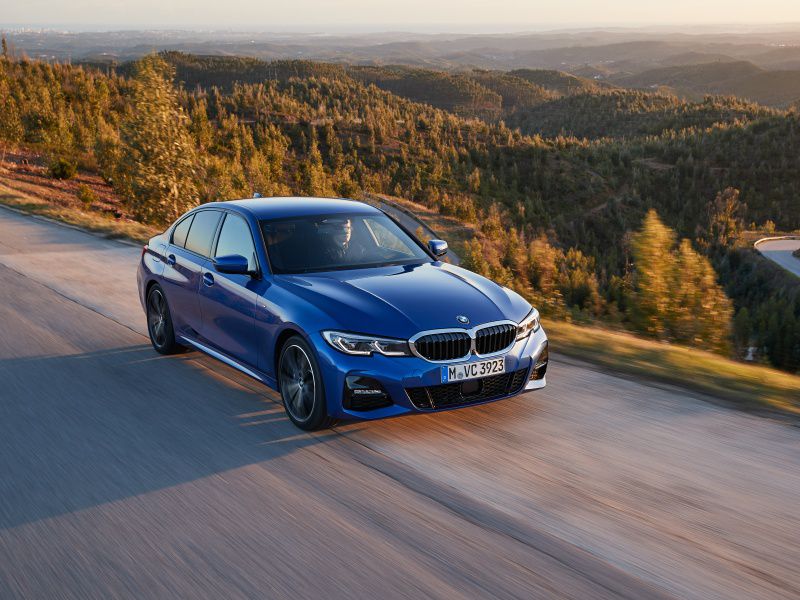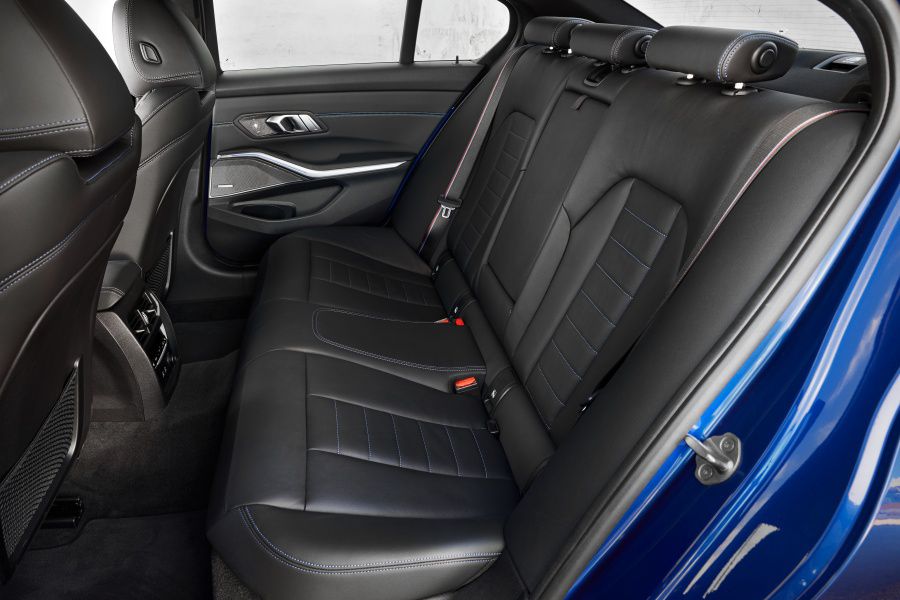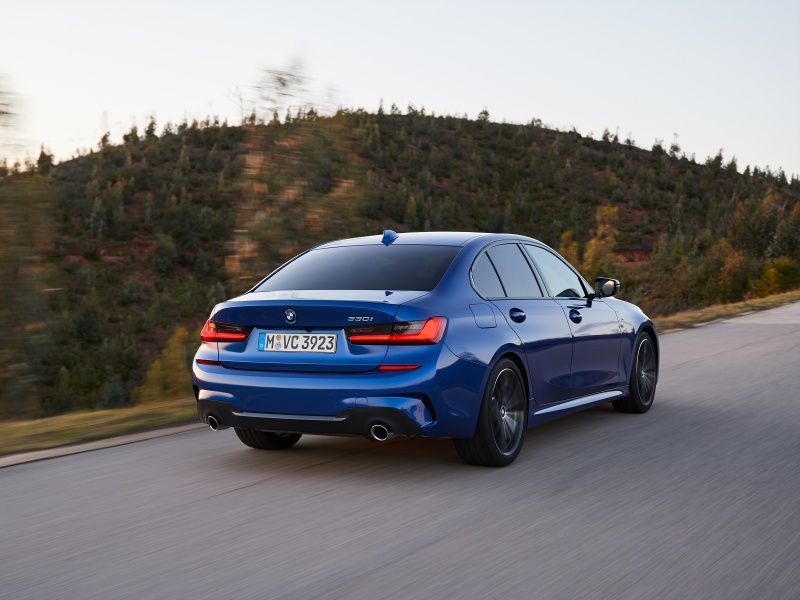Recent Articles
Popular Makes
Body Types
2022 BMW 3 Series Road Test and Review

BMW 3 Series ・ Photo by BMW
If you want to know the definition of a European sports sedan, just look at the BMW 3 Series. For decades, the 3 Series has reigned at the epitome of Eurosport four-doors even as it has helped BMW retain its self-awarded title as the “Ultimate Driving Machine.” Advertising slogans aside, the 2022 BMW 3 Series is certainly one terrific driving machine. It offers great looks, ample power, and utter poise. In a 3 Series, the driver’s inputs result in almost immediate action that is commensurate, and those who like to motor at the upper edge of a vehicle’s capabilities find that downright endearing. The 3 Series is a car you can push and balance on the knife’s edge, and it won’t disappoint you with terminal understeer, nor will it suddenly flip on you at an inopportune moment. While that kind of behavior is nice in any vehicle, it is especially appreciated in a reasonably priced luxury sedan that will transport five adults in comfort. Here is our road test and review of the 2022 BMW 3 Series.
Exterior Style
Though its exterior styling has remained evolutionary versus revolutionary over the years, the 2022 BMW 3 Series is both contemporary and attractive. It is playing in a segment with several good-looking competitors including the all-new 2023 Mercedes-Benz C 300 and the 2022 Audi A4, yet it holds its own. It’s an inch or so longer than the C 300 and the upstart 2022 Genesis G70, and it is almost 2 inches shorter than the Audi A4. In other words, it finds itself right in the middle of its segment. It sports the famed “twin kidney” grille common to the BMW, and in its current iteration, the grille has not grown to the outsized proportions it has on more recent BMW offerings. Like the C Class and the G70, it is a rear-drive platform in standard form. The Audi A4 is offered only as a quattro all-wheel-drive vehicle, and its roots are front-drive.

Photo by BMW
Powertrains
The engine in the base 330i is a 2.0-liter turbocharged four-cylinder that produces 255 horsepower and 295 lb-ft of torque. It, like all the 3 Series powerplants, is teamed with a stalwart eight-speed automatic transmission that can be manually shifted. The next powertrain in the lineup pairs the 2.0-liter turbocharged engine with a mild hybrid arrangement. With the help of an electric motor and moderately sized battery pack, total system output is 288 horsepower and 310 lb-ft of torque. BMW engineers have increased the electric motor’s efficacy by creating an Xtraboost mode that is like a shot of adrenaline for the car. And if you want to feel your adrenaline build, get behind the wheel the M340i. Its turbocharged 3-liter inline six-cylinder engine whirs out 385 horsepower and 369 lb-ft of torque. Rear-drive is the standard configuration, while all-wheel-drive variants are available as well. The BMW xDrive all-wheel-system improves traction on slippery surfaces helps the powerful six-cylinder M340i turn its torque into forward motion.

Photo by BMW
Driving Impressions
Though some might prefer the “hooked up” feel of the all-wheel-drive 330i xDrive and M340i xDrive, there is something intoxicating about the handling of the rear-drive 3 Series vehicles. Of course, the M340i is the performance version of the sedan, so it has the highest limits. That said, most drivers will find a great deal to like about the driving demeanor of the 330i and 330i Drive. The 330e plug-in hybrid has a nice road feel all its own. It benefits from the precision addition of electric-motor torque when necessary. With the exception of the Xtraboost, that e-torque doesn’t spice things up like a shot of Tabasco; it simply slides in almost imperceptively to make the drive smoother and more effortless. Both steering and braking are well-sorted-out. If we had the choice of any five-passenger sedan on the market for a day of canyon-carving, the BMW 3 Series would at the top of the list. Happily, its passengers will also find it reassuringly comfortable.

Photo by BMW
Interior Design
Like the 3 Series’ exterior, its interior doesn’t break any new ground. The good news is it “looks like a BMW,” although the traditional round instruments of old have been replaced by a digital driver information display. The steering wheel doesn’t have a large diameter, but it does have a thick section for easy gripping. Unlike many current luxury vehicle that use a variety of gear-selector types, the 3 Series retains a big traditional shifter on the center console. No manual transmission is available, however. The 3 Series uses a rotary controller next to the shift knob for its infotainment system. The standard 8.8-inch digital display is not put on exhibition in the same way as in some contemporary competitors, but it is amply sized and easy to read. A 10.25-inch display and head-up display are optionally available. As expected, the front bucket seats are comfortable, adjustable and feature good bolstering to hold you in place during your canyon runs. The rear bench seat can be heated if you tick the right option box.

Photo by BMW
Infotainment
The BMW 3 Series offers a couple of iterations of the iDrive infotainment system. The supply chain is wreaking havoc to the 3 Series' tech offerings, so the iDrive system with the 8.8-inch display screen doesn’t currently offer navigation. To make up for this, BMW is offering Live Cockpit Pro, which includes nav, as a reasonably low-cost option. The Live Cockpit Pro package includes a digital 12.3-inch screen and a high-resolution 10.25-inch control display. The full-function system has Bluetooth, two USB ports, and wireless Apple CarPlay and Android Auto compatibility. BMW Teleservices and automatic emergency calling are supported, too. The iDrive 7.0 operating system accepts voice commands and commands input into the iDrive console-mounted controller. Because of supply-chain hurdles, some 3 Series cars might be equipped with touchscreens but some might not. So check on the vehicle before you buy it.

Safety & Driver Aids
The BMW 3 Series offers a long list of available active safety and driver-assist features. Forward-collision warning and automatic emergency braking are standard advanced driver assists. The optional Driving Assistance Package includes active blind spot detection, Active Driving Assistant, lane departure warning, and park distance control. Active Driving Assistant includes pedestrian and frontal collision warning with city collision mitigation. It provides varying degrees of automated braking based on speed conditions. One of the 3 Series’ most useful safety options is adaptive cruise control with stop and go. It automatically accelerates and decelerates to maintain the speed set by the driver or imported from the available traffic sign recognition system. Operational from 0-100 mph, the system will resume forward motion without driver input if the stop is less than 30 seconds long. The BMW 3 Series does very well in the National Highway Traffic Safety Administration 5-Star Safety Ratings. Both rear-drive and all-wheel drive versions get an overall 5-star score, the highest honor.

Photo by BMW
Fuel Economy
The BMW 3 Series offers good fuel economy, led, of course, by the plug-in hybrid 330e. In rear-drive form, the 330e is rated at 75 MPGe by the Environmental Protection Agency (EPA). That same model with xDrive all-wheel-drive has a 67 MPGe mark. (Compare the MPGe figure with a car’s combined mpg to get a sense of the savings.) A conventionally powered 330i sedan with the 2.0-liter turbocharged four-cylinder engine delivers an estimated 26 mpg city and 36 mpg highway for a combined 30 mpg. All-wheel-drive drops fuel economy by 1 mpg in city driving and 2 mpg on the highway. The high-performance M340i sedan is EPA-rated at 23 mpg city/32 mpg highway/26 mpg combined. The Audi A4 is a mild hybrid that turns in 26 mpg city and 34 mpg highway for a combined rating of 29 mpg.

Photo by BMW
Cargo Capacity
The BMW 3 Series has ample room for five occupants and their luggage. Its cabin is virtually the same size as its key competitors, so legroom, hiproom, and headroom are very similar. But the 3 Series scores with a much larger trunk than the key European and Asian rivals. It offers 17 cubic feet of luggage space. In comparison, the all-new 2023 Mercedes-Benz C Class has 12.6 cubic feet, the Audi A4 has 12 cubic feet, and the Genesis G70 has 10.5 cubic feet. With five adults inside the 3 Series, none of its passengers will feel cramped, but the passenger sitting in the middle of the rear bench seat might cross elbows with the outboard passengers.

Photo by BMW
Trim Levels
The 2022 BMW 3 Series doesn’t bury customers with a laundry list of trim levels. Instead, there are three basic models: conventional 330i sedan, 330e plug-in hybrid, and sports-oriented M340i. All are available in standard rear drive and xDrive all-wheel-drive configurations. Instead of trims, BMW gives 3 Series buyers the choice of a plethora of option packages and standalone options. The sedan can be purchased with a variety of interior colors, upholstery, and trim, including genuine wood. One of the more intriguing (and expensive) packages is the Dynamic Handling Package. It bundles a locking rear differential and an M-tuned adaptive suspension. It has Dynamic Damper Control and air cushioning on the rear axle to deliver even sportier driving characteristics than the stock suspension. Another package includes heated front and rear seats, heated steering wheel, keyless entry, four-way power lumbar support, and “gesture control.” The last of these allows drivers to accept incoming calls, reject calls, adjust volume, and activate a 360-degree surround-view monitor by using five simple hand gestures.

Photo by BMW
Pricing & Value
For decades, the BMW 3 Series has set the standard in its segment. With a starting price of about $41,500 plus a destination fee, the 330i is well-equipped even in base form. The xDrive all-wheel-drive system adds $2,000 to the price. The performance-luxury M340i has a base price of $54,700 plus the destination fee. Again, all-wheel drive adds $2,000 to the sticker price. The plug-in hybrid 330e combines added performance with significantly better fuel economy. It also offers electric-only range of a bit over 20 miles on a full charge. Base price for the 330e plug-in is $42,950. And if you want all-wheel drive, it'll be an additional $2,000. Because the price premium for the 330e is so small, it is the best value of the bunch. And anyone who enjoys driving for driving’s sake will find a great deal value in the M340i. Any way you carve it, the BMW 3 Series remains a top choice in the segment.

Photo by BMW